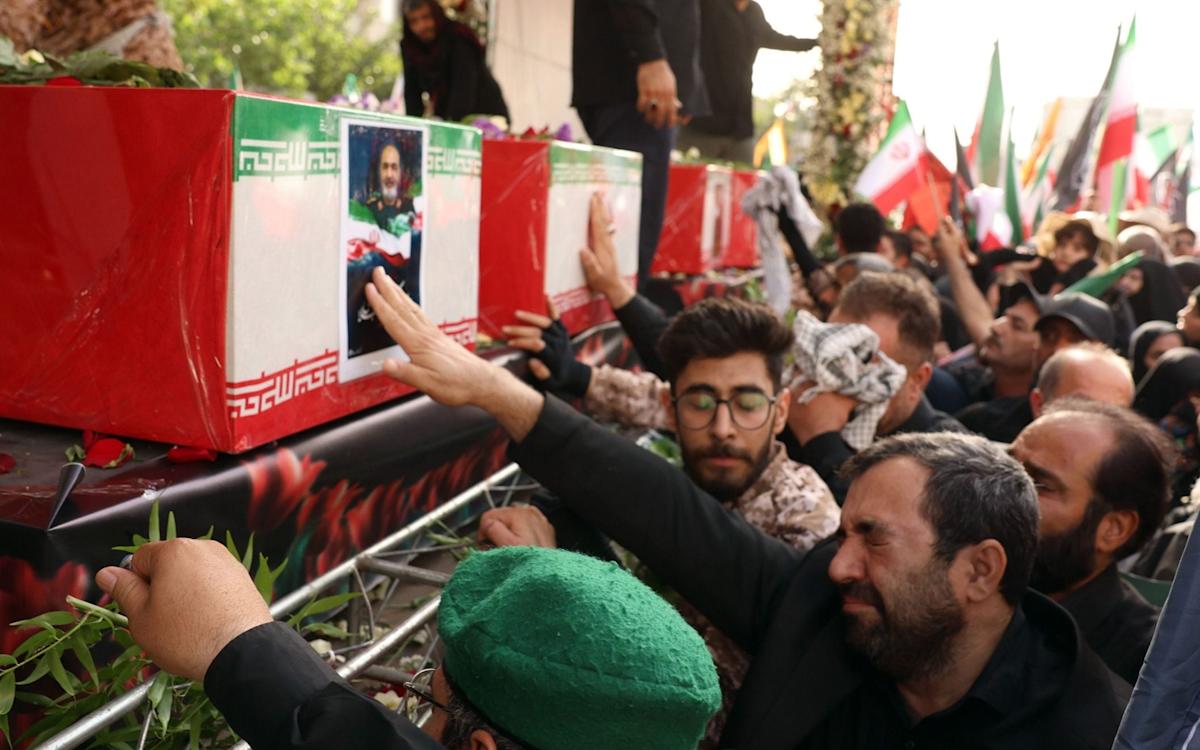Donald Trump saved Iran’s Supreme Leader from “a very ugly” death, the US president said last night with the Ayatollah Ali Khamenei still in hiding amid a fragile ceasefire.
Khamenei has not been seen in public since the outbreak of the 12-day war between Israel and Iran, but in a televised address aired on Thursday, he declared Iran had “dealt a hard slap to America’s face”.
His comments triggered a backlash from Mr Trump who on Friday said he knew “exactly where he [Khamenei] was sheltered, and would not let Israel, or the US Armed Forces… terminate his life”.
On his Truth Social channel, Mr Trump said: “I saved him from a very ugly and ignominious death, and he does not have to say: ‘Thank you, President Trump!’”
Khamenei’s absence was notable on Saturday as thousands turned out on the streets of Tehran for the funerals of Iran’s top commanders and nuclear scientists killed in recent Israeli air strikes.
Senior political and military figures attending the funeral on Saturday included Masoud Pezeshkian, the president of Iran, and Esmail Qaani, head of the Quds Force, the foreign operations arm of the Islamic Revolutionary Guards Corps (IRGC).
At least 16 scientists and 10 senior commanders were among those mourned, according to state media.
Israel also targeted Iran’s military infrastructure, and the US – on Mr Trump’s orders – bombed Tehran’s nuclear programme.
On Thursday, Israel Katz, Israel’s defence minister, told Channel 13: “If he had been in our sights, we would have taken him out.” He also admitted that Israel “searched a lot” for the elusive leader.
Also present at the funeral was Ali Shamkhani, Khamenei’s senior advisor, who was seen for the first time since the war. He too was targeted and wounded during the conflict, and was seen using a walking stick in footage from state television.
Credit: Reuters / Anadolu
Among those buried were Mohammad Bagheri, a major general in the IRGC who was second-in-command of the armed forces after Iran’s supreme leader; Mohammad Mehdi Tehranchi, a nuclear scientist; and Hossein Salami, an IRGC commander. They were all killed on the first day of Israel’s surprise attacks on June 13.
State media said four women and four children were also among the coffins draped in Iranian flags, photos, rose petals and flowers.
The Iranian health ministry said 610 people were killed in Iran during the 12-day war, 13 of them children and 49 women, before a ceasefire came into effect on Tuesday. More than 4,700 were injured.
However, the Human Rights Activist News Agency (HRANA) claimed the number was far higher, citing at least 1,054 deaths and 4,476 injuries among civilians and military personnel. In Israel, there were 28 deaths and 3,343 people were treated in hospitals.
Mass arrests took place across Iran on Saturday morning in the wake of the war, with over 800 held on charges of supporting Israel and at least six executed. HRANA reported that at least 35 Jewish citizens in Tehran and Shiraz were summoned and interrogated by security forces.
The Jewish community in Iran is centuries old and at its peak numbered hundreds of thousands but now stands at just 10,000. In 2011, Iran made it illegal for Iranians to travel to Israel.
“According to a source close to the families, the officers mainly questioned these individuals about their family contacts with relatives in Israel and emphasised that they should refrain from any phone or internet communication abroad for the time being,” the rights group said on Saturday.
“This wave of summonses unfolding amid heightened military tensions between Iran and Israel marks one of the largest such incidents since the early years following the 1979 Revolution. The move starkly contradicts the Islamic Republic’s official narrative of providing ‘equal rights for Iranian-Jewish citizens’.”
In spite of the authorities trying to portray Iranian Jews as secure and fully integrated citizens, HRANA said that there has been “unprecedented pressure” on the minority in recent weeks.
On Saturday, senior Iranian politicians reiterated calls to cut ties with the UN’s nuclear agency, the International Atomic Energy Agency (IAEA).
Iran’s parliament voted unanimously last Thursday to cut ties with the agency. If it bans the IAEA, the full impact of the bombing by the US and Israel of Iran’s nuclear sites in Fordow, Isfahan and Natanz, will be more difficult to assess.
“Iran had a very vast, ambitious programme, and part of it may still be there. And if not, there is also the self-evident truth that the knowledge is there,” Mr Grossi told CBS in an interview.
Mr Grossi said Iran had not yet asked IAEA inspectors to leave the country.
